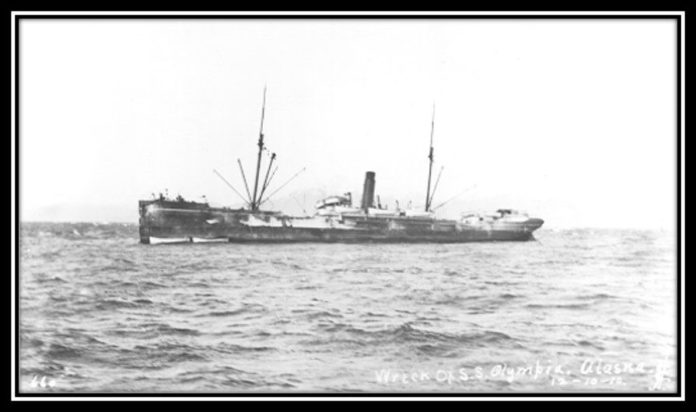
Welcome back to our series on the naval presence in our area, specifically the radio stations that connected Alaska to the Lower 48. The Native Village of Eyak has been cleaning the Mile 14 station area and we will share more about that specific site in the next edition. Today we continue at the first station, Point Whitshed.
Professor George Hanscom, the naval engineer stationed at Whitshed, was seemingly a civilian radio genius, as were many of the naval men in the early days of these remote radio stations. Many had to improvise equipment and create the technology as they went. Listen to this description from a naval station in California and hear about the role Hanscom played in naval radio:
“My receiver had been a rolling pin wrapped with bell-wire as a tuner, and (I made) a coherer by boring a hole in a piece of broomstick. The hole was filled with iron filings and the ends closed with zinc plugs, with a tapper made from a doorbell with the gong removed. My receiving condenser was an old telephone condenser of unknown value, and the telephone receiver had been discarded by the telephone company after it was badly damaged in a warehouse fire. My antenna was a single bell-wire about 160 feet in length from a warehouse to my home, insulated by means of broken necks of bottles. My transmitter was a Ford spark-coil and a loading-coil made by the old Electro Importing Company. The key was home-made.
Fred Ward, of the Carborundum Company at San Francisco, gave me a bucket of carborundum scraps and I constructed a detector using a piece of carborundum, with a phonograph needle screwed against it under pressure. It was so satisfactory that I took several of these detectors with me when I enlisted in the Navy. Two years after I had been using carborundum George Hanscom, Radio Aide at Mare Island Navy Yard, invented the very same thing, and it became standard in use in the coastal radio stations.”
A rolling pin? Can you imagine? The Navy was still under pressure to improve the system, so between 1911 and 1914 the Navy sent a series of three Alaskan Radio Expeditions to build additional stations. The 1911 Alaskan Radio Expedition, supported by the USS Buffalo, built stations on Woody Island near Kodiak, on St. Paul in the Pribilof Islands, and at Dutch Harbor near Unalaska.
The USS Nero followed with the 1912 Alaskan Radio Expedition, which built a new station on the island of Unalga, an auxiliary station on St. George in the Pribilofs, and performed additional work at the other five stations. The Buffalo returned with the 1914 Alaskan Radio Expedition, which upgraded and repaired all seven stations. These expeditions involved a mix of naval and civilian personnel — the 1912 expedition consisted of two officers, 32 civilians (including radio experts and manual laborers) and 38 enlisted men.
By the end of the summer in 1914, the Whitshed establishment could boast of having the following structures: a four-room cottage for the electrician, an eight-room cottage for the station force, a powerhouse, a coalhouse, a paint and oil house, a storehouse, a boathouse and a 230-foot wharf. There was a 2-foot gauge railway from the end of the wharf to the station buildings, fuel tanks, a water and sewer system and two steel towers 200 feet in height.
The Point Whitshed station definitely served its purpose. In 1910 it received a distress call from the S.S. Olympia, which had run aground on Bligh Reef, (sound familiar?) 40 miles southwest of Valdez. The naval radioman contacted the Army radio station at Fort Liscum and rescue vessels were dispatched in time to save the lives of the captain and 116 passengers and crewmembers, although the vessel was lost.
Despite all the attention and ruckus, the Point Whitshed location eventually proved to be an unsatisfactory locale for radio work. The outbreak of WWI resulted in the closure of the Point Whitshed naval radio station in 1917 when it appeared to be vulnerable to amphibious attack from enemy ships that theoretically could shell the site.
The outbreak of World War II also provided the Navy with an excuse to establish the Radio Corporation of America (RCA) after Congress refused to grant them a monopoly over all radio transmissions.
The Cordova Historical Society recently received some photos of families stationed at Point Whitshed, and plans to share these once they are processed!
Next week, we will move to Mile 14 and the Naval Radio Receiving Station that was located there.












